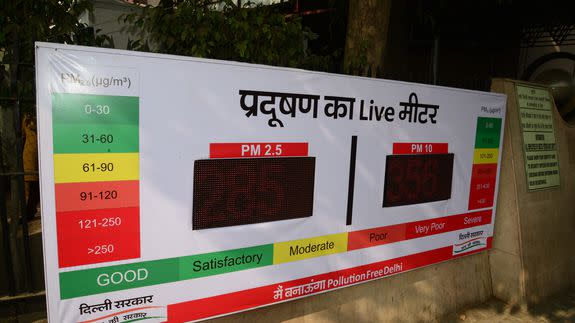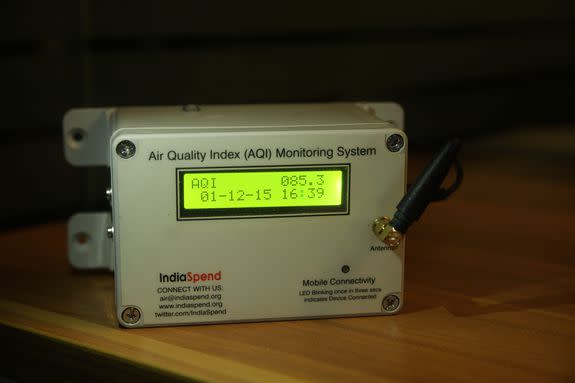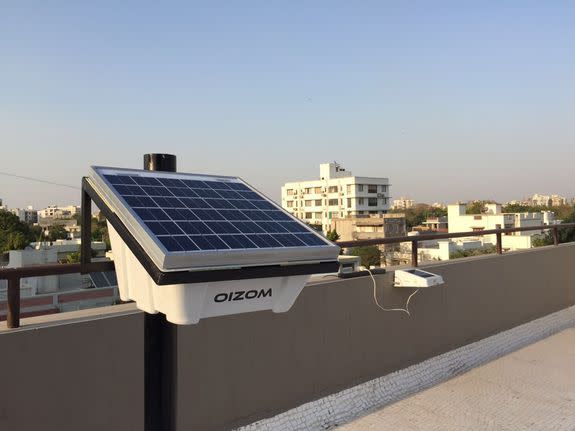How low-cost tech can help India monitor the air it breathes

India has some of the most unhealthy air in the world, but the wake up call came in 2014, when its capital New Delhi was ranked by the World Health Organisation as the most polluted city in the world.
Over the next two years, reports on its air quality remained grim. The country's air pollution levels reached their highest levels in 2015, after being on rise for the last decade. For the first time, India's air was also found to be more polluted than China's. This year, WHO revealed that the country was home to half of the world's most polluted cities. Other studies indicated clear health risks, with 1.6 million premature deaths in India linked to air pollution.
SEE ALSO: Indians can now check the air pollution levels in their city with just a tweet
In a first step towards being more transparent about its pollution crisis, India launched its first air quality index to monitor pollution in 10 cities in 2015. Despite this, awareness and knowledge of air pollution remained low and inadequate.
To remedy this, a number of Indian startups are building low-cost pollution sensors and IoT devices to measure air pollution on a hyper-local level and at a wider scale in order to gain a wider knowledge of the problem and how it can be tackled. They argue that more comprehensive pollution data can help increase public awareness about the extent of the problem and help the government find solutions.
"The government devices solve a different purpose, at best help in regulatory decisions." says Mrutyunjay Mishra, who runs an analytics company Juxt-SmartMandate. "The data is not publicly visible, and even if they are for some locations like Delhi, it doesn't drive 'community action'. The data is far from being open and is not inviting the complex network to come and work with the data to drive action. The need is to get a lot of people come and use their collective intelligence to develop a solution."
Moreover, government-operated pollution monitors are often expensive and therefore few in number. "The number of government pollution monitors, besides New Delhi, is in single digits," Ronak Sutaria of IndiaSpend explains. "That is, in most polluted cities, the govt. has installed a single pollution monitor for a million people. That seems woefully inadequate."
There is also the question of how effective the operations of the government's monitors are. Sutaria cites the example of a recent study that revealed that while Delhi has 21 air pollution monitors, there were significant long gaps in their monitoring when they may have stopped working.
IndiaSpend's Breathe initiative is one of the organisations running a network of independent air quality monitoring devices across India. In a step towards making live air pollution air data more democratic, IndiaSpend partnered with Twitter India to let users get real-time data on air pollution in their neighbourhood with just a tweet.
"It helps make the air quality data more actionable for people as they just have to send their location and within seconds they are provided information about the air quality levels in their area," Sutaria says.
IndiaSpend's network uses low quality sensors fitted with GPRS transmitter, which have deployed in around 40 devices in Mumbai, Delhi, Bangalore, Chennai, Patna and Lucknow. It is also working on deploying devices in cities such as Dehradun, Ahmedabad, Varanasi, Allahabad, Kanpur and Bhopal.

The devices are built in India, using a digital Particulate Matter (PM) sensor from China and then doing the controller board and data transmission integration locally. The PM sensor is a laser sensor which is connected to a controller board which receives data from the sensor. A GPRS module transmits the data to IndiaSpend's servers using a 2G connection.
"The goal of the low-cost devices and analysis provided by IndiaSpend is to involve citizens in seeing the effects of policies as well as their own actions on the air quality levels in the area surrounding their own houses," Sutaria says. "When devices are owned or installed by people themselves, they tend to be more involved in the understanding of the problem and in demanding that action be taken on conditions which are harmful to them."
Delhi-based analytics company Juxt-SmartMandate (JSM) takes this a step further with its non-profit platform, India Open Data Association (IODA). Its open environment data project was started with the aim of creating a "simple, scalable and easy to deploy solution" to bring in "real time status of the environment from thousands of locations in India". The data is also open source, with the device design and data APIs being accessible to everyone.
"If the data remains open, it will attract all stakeholders, not only general public, but also the people who influence public policy," IODA founding member Mrutyunjay Mishra says.
Piloted during the massive Hindu festival Nashik Kumbh Mela, JSM now has 30 environmental monitoring kits installed in Delhi. These have multiple sensors, and are connected to either analog, digital or UART ports of a base shield, which is in turn connected to a IoT board with data being transferred through SIM cards. In June, IODA in association with Oizom also launched AirOwls, which measure dust particulate matter. Mishra says that while the readings sometimes differ from government monitors, the devices are calibrated to determine the differences.
IndiaSpend and JSM aren't alone. The Chennai-based Sensors Without Borders provides hyperlocal and open source environmental data on air and water quality gathered from low-cost devices to help with governmental policy making and support community organisations.

In April, data intelligence company SocialCops conducted an experiment with five low-cost GPS-enabled IoT devices that were installed on five auto rickshaws for a month. The idea was to measure PM 10 levels every 30 seconds as the autos travelled all over Delhi.
"There is little data to understand pollution at a deeper level — how it varies within a city, which parts of the city have higher pollution levels, what could be the causes for that. The government pollution monitoring stations are few and stationary and may not give us insights at a granular level," Surendran Balachandran of SocialCops says. "Autos, on the other hand, can travel to various corners of the city through out the day, which gives us the ability to collect data from multiple locations and at much lower costs.
In the long-term, these startups hope that greater knowledge about the air quality levels in their neighbourhood will lead to community participation in dealing with air pollution at a local and city-wide level.
"Our goal is only to involve as many community organizations as possible and to build the tools & data which will allow them to demand for what they feel is appropriate & suitable for their own neighbourhood." Sutaria says. "Improving air quality is not a one size fits all solution. It will require many small actions which will eventually lead to a larger change"
